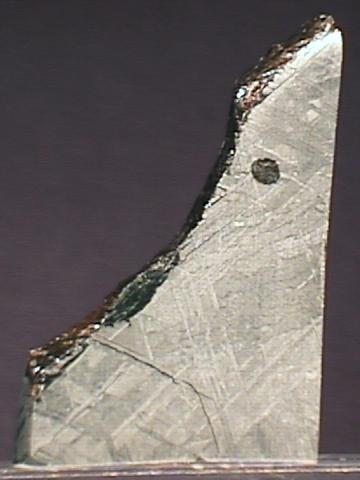
IRON
Specimen iro-19
$ 29.00
Dims: 1.6 x 1,1 x 0.1" (4.1 x 2.8 x 0.3 cm)
Wt: 19.2 g
Gibbeon fall, near Hoba, Namibia
A small, thin slice of an Iron "siderite" meteorite makes up this specimen. The piece is cut, polished, and acid-etched on all surfaces but one. This other surface shows the rough, pitted and rust-stained natural surface of the meteorite. The other surfaces have the standard silvery-gray coloration and metallic luster of Iron and show the geometric patterns known as Widmanstatten figures that acid-etching exposes. A small, black carbonaceous nodule is embedded in the metal. The piece has been coated with a clear lacquer to prevent rust.
 Amethyst Galleries' Mineral Gallery MINERALS |
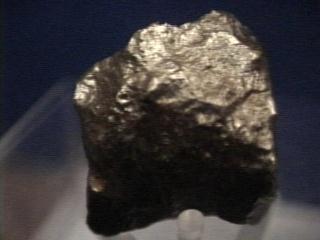
IRON specimen iro-1
$ 59.00
$ 59.00
Dims: 1-1/2" x 1-1/2" x 5/8"
Wt: 2.5 oz
Canyon Diablo, Coconino County, Arizona, U.S.A.
Yes, we actually have some real iron meteorites! This particular example has a very dark, oxidized metallic color and luster, with a few rust-coated pits. It is small but quite heavy, and of an amorphous shape. Before we got these in, I had only seen Meteorites in museums. Now we're making them available to you!

iro-1 ($ 59.00)
Canyon Diablo, Coconino County, Arizona, U.S.A.
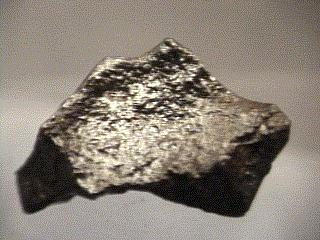
IRON specimen iro-2
$ 56.00
$ 56.00
Dims: 1-7/8" x 1-1/4" x 1-1/4"
Wt: 2.3 oz
Canyon Diablo, Coconino County, Arizona, U.S.A.
One of our new selection of Meteorites, this particular specimen has somewhat of a triangular cross-section to it, with concave surfaces. It is the least pitted of our selection, showing little actual rust, but still possessing a dark color and oxidized-metallic luster. It may have traveled millions of miles in its existence- why not give it a nice place to rest?

iro-2 ($ 56.00)
Canyon Diablo, Coconino County, Arizona, U.S.A.
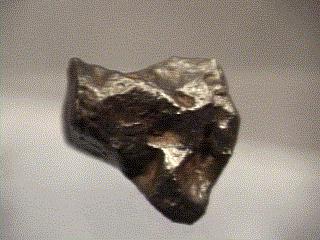
IRON specimen iro-3
$ 47.25
$ 47.25
Dims: 1-1/8" x 1-1/4" x 1"
Wt: 1.9 oz
Canyon Diablo, Coconino County, Arizona, U.S.A.
I think that this is my personal favorite in the Meteorite category. It has by far the most pitting, with a thin dusting of rust lining each one, giving it the most "traveled" appearance.

iro-3 ($ 47.25)
Canyon Diablo, Coconino County, Arizona, U.S.A.
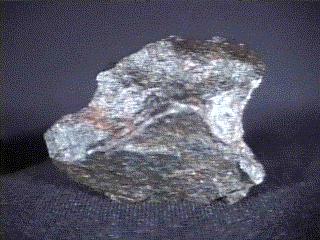
IRON specimen iro-5
$ 79.00
$ 79.00
Dims: 2-1/4" x 1-3/4" x 3/4"
Wt: 3.12 oz
Gibbeon, Hoba, Namibia
This little Siderite meteorite is part of a find that is located in Namibia, whose total weight is estimated at 70 metric tons or more. It is irregularly shaped, and has substantial rusting and pitting on it, even after attempts to clean it with a phosphoric acid gel and a wire brush! It has been sprayed with a petroleum distillate for protection, but has scuff marks along some of its sharper edges, exposing the metal. Being a nickel-iron alloy, one could conceivably cut this meteorite with a thin kerf saw, and polish and acid-etch the cut faces to expose the lines and patterns that form from the cooling of the once-molten alloy, called Widmanstatten figures. Although there is no guarantee, there is a good probability that such figures will be present.

iro-5 ($ 79.00)
Gibbeon, Hoba, Namibia
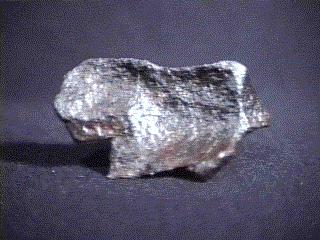
IRON specimen iro-6
$ 85.00
$ 85.00
Dims: 2-3/4" x 1-5/8" x 3/4"
Wt: 3.33 oz
Gibbeon, Hoba, Namibia
Though not possessing any crystal form, Siderite meteorites such as this one often possess shapes and aspects of form that say "I am a meteorite." This piece seems to be one of them. One side of it has a very large, slightly concave face that I have seen on a lot of other metallic meteorites from a few different localities. Of course, the fact that it is heavy, rusty, and comes from a known African locality also helps. My attempts at cleaning up the specimen were not fully successful, but there is a light coating of a petroleum-based liquid on it to help protect it. There is faint wear on its sharper edges, with a slight metallic luster showing, and there is a lot of rust and pitting visible. I have a smaller one that looks a lot like this one(from Arizona, though) on layaway at the shop.

iro-6 ($ 85.00)
Gibbeon, Hoba, Namibia
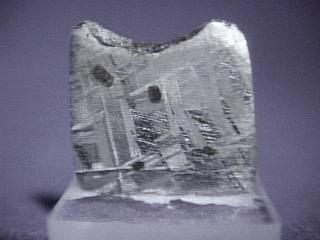
IRON specimen iro-8
$ 20.00
$ 20.00
Dims: 1.1" x 1.1" x 0.1"(2.8 x 2.8 x 0.3 cm)
Wt: 13.9 g
Gibbeon, Hoba, Namibia
This flat, square specimen is basically a small slice of meteorite that is cut on all sides but one, where its natural skin is visible. The cut surfaces have been polished and acid-etched, so that Widmanstatten figures are visible. Along with these unusual designs, there are spherules of a carbon material(I can't remember its name) visible that are locked in the iron-nickel matrix. These spherules identify the original meteorite as a siderolite, a metallic meteorite that has stony inclusions- these types of meteorite are rare even for meteorites. Needless to say, the specimen has the typical opacity, gray color, and metallic luster of nickel-iron.

iro-8 ($ 20.00)
Gibbeon, Hoba, Namibia
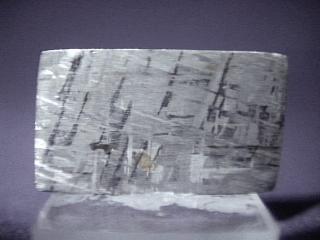
IRON specimen iro-9
$ 20.00
$ 20.00
Dims: 1.5" x 0.9" x 0.1"(3.8 x 2.3 x 0.2 cm)
Wt: 13.5 g
Gibbeon, Hoba, Namibia
This thin tablet was cut from a siderolite, a metallic meteorite that has stony inclusions; the inclusions are sphericles of a substance that is made up mostly of carbon. The specimen is long, flat, rectangular in shape, and has been cut on all sides. The faces have been polished and then etched with acid, bringing out a design of intersecting lines in the material that are called Widmanstatten figures. These lines occur due to the presence of two slightly different iron-nickel compounds present in the meteorite called kamacite and taenite. As the molten mass cools, these compounds align themselves in certain directions as they crystallize.

iro-9 ($ 20.00)
Gibbeon, Hoba, Namibia
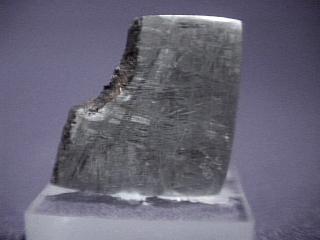
IRON specimen iro-10
$ 20.00
$ 20.00
Dims: 1.1" x 1.1" x 0.1"(2.8 x 2.8 x 0.3 cm)
Wt: 10.0 g
Gibbeon, Hoba, Namibia
This thin, square-shaped tablet of Iron-nickel comes from a siderolite meteorite, a variety of metallic meteorite that has stony inclusions trapped within. A small spherule of a dark material that is composed mainly of carbon is visible on one of the specimen's main faces. The piece has been cut on all but one side, where some of the natural outer surface of the meteorite is still visible. The cut faces have been polished and acid-etched, bringing out the Widmanstatten figures that are made up of crystallized polymorphs of the nickel-iron compound, called kamacite and taenite that intersect each other at certain angles. It has the standard gray color and metallic luster of iron-nickel. Metallic meteorites represent about 6% of all stellar material that reaches Earth.
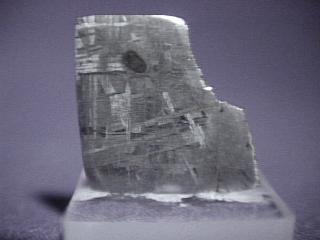

iro-10 ($ 20.00)
Gibbeon, Hoba, Namibia
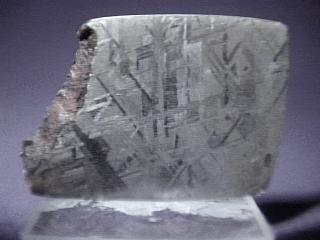
IRON specimen iro-11
$ 25.00
$ 25.00
Dims: 1.5" x 1.1" x 0.1"(3.8 x 2.8 x 0.3 cm)
Wt: 16.4 g
Gibbeon, Hoba, Namibia
This thin, rectangular slab was cut from a metallic meteorite with stony inclusions called a siderolite. All but one face on the piece has been cut; the one that is uncut shows a small portion of the meteorite's outer surface, which is rather dark, uneven, and rusty. The other faces are flat; they have been polished and etched with an acid so as to bring out designs on the faces caused by the alignment of two polymorphs of the iron-nickel compound. These designs are called Widmanstatten figures Along with these designs are a tiny, dark, oval spherules of a compound made up mostly of carbon. A siderolite meteorite is a variety of metallic meteorite that contains stony inclusions- this type of meteorite represents a small fraction of the total stellar material that actually makes it to the Earth's surface.

iro-11 ($ 25.00)
Gibbeon, Hoba, Namibia
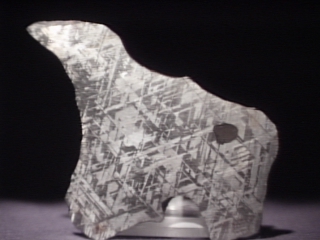
IRON specimen iro-12
$ 400.00
$ 400.00
Dims: 4.8" x 4.0" x 0.1" (12.2 x 10.2 x 0.3 cm)
Wt: 5.88 oz. (166.7 g)
Gibbeon, Hoba, Namibia
This specimen consists of a slab that was cut and polished from a large chunk of the Gibbeon meteorite fall near Hoba, in the African country of Namibia. Its edges still possess the natural outer surface of the meteorite, which are oxidized and a rusty-brown in color. The cut faces have been polished and acid-etched so that the Widmanstatten figures, caused by the interaction of crystals of kamacite and taenite, are visible. One of the polished, etched sides also shows the round cross-section of a piece of brownish, submetallic material that was included in the Iron-nickel matrix. I am not sure of the name of the material, but I do know that it is a carbon compound of some sort. Thus, the meteorite that this piece was cut from is a siderolite, which is a rare variety of the already rare meteorite family. There is a very small amount of rust in one or two areas on the faces; such a piece should be regularly coated with a thin layer of a light petroleum-based oil to prevent further rusting.

iro-12 ($400.00)
Gibbeon, Hoba, Namibia

$ 225.00
Dims: 1.5" x 1.0" x 0.8" (3.8 x 2.5 x 2.0 cm)
Wt: 1.01 oz. (28.8 g)
Hungtukun Massif, Taymyr Peninsula, Krasnoyarsk region, Siberia, Russia
Though quite small, this may be the rarest specimen that we have in stock. It consists of a basalt host rock in which a substantial amount of native Iron has formed. The important aspect is that it is not of meteoric origin. This is native Iron that has formed through complex chemical processes in the Earth's crust! A flat face has been cut into the specimen and polished so that the iron can easily be seen. It has a moderate silvery-white coloration and the standard metallic luster. The polished face has been coated with a clear lacquer to prevent rust. The rest of the specimen's surface is dull and uneven and has a dark brown coloration and a dull luster. There is a small patch of a pale-colored material present in one area that has been rust-stained, but it is nearly impossible to discern the Iron from the basalt host, except on the cut surface.

Hungtukun Massif, Taymyr Peninsula, Krasnoyarsk region, Siberia, Russia
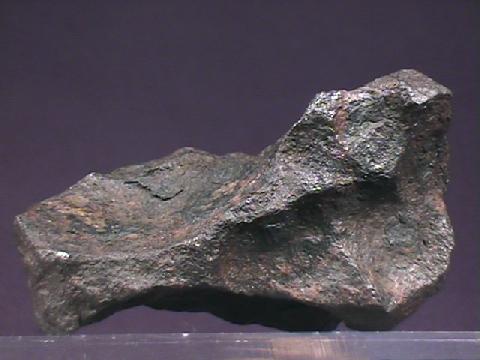
IRON specimen iro-14
$ 180.00
$ 180.00
Dims: 3.4 x 2.6 x 1.8" (8.6 x 6.6 x 4.6 cm)
Wt: 1 lb., 4.3 oz. (575 g)
Gibbeon, Hoba, Namibia
This sizable hand specimen consists of a piece of meteoric iron which was part of one of the largest meteor falls ever found. This particular piece has the odd, amorphous form that is standard for meteorites, with slightly convex surfaces that are quite rusted. It has a dark reddish-brown coloration and a dull, matte luster due to the rust, but some of the more exposed edges are worn enough so that one can see the Iron's silvery-gray color and metallic luster peeping through. As with all meteorites, there is no host rock associated with this piece.
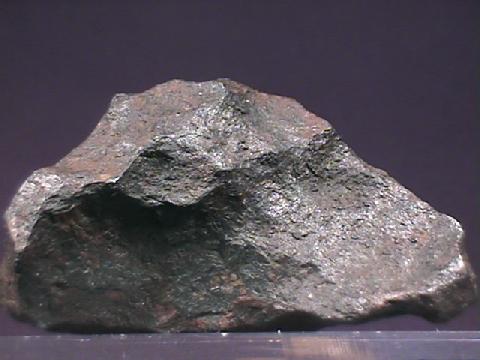

iro-14 ($180.00)
Gibbeon, Hoba, Namibia
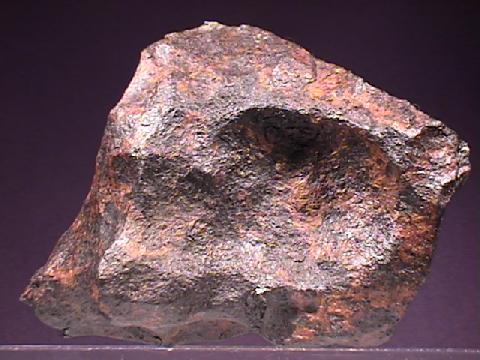
IRON specimen iro-15
$ 350.00
$ 350.00
Dims: 4.5 x 4.0 x 3.0" (11.4 x 10.2 x 7.6 cm)
Wt: 3 lbs., 9.1 oz. (1.620 kg)
Gibbeon, Hoba, Namibia
A sizable siderite meteorite makes up this Iron specimen. It is coated with oxidation that has both a dark brown and a rusty coloration and is matte in luster. However, its more exposed edges are worn, so that snatches of silver-gray color and metallic luster are visible. Like most meteorites, it has many concave faces and curved edges. It is quite heavy, of course, and has a waxy luster that is caused by a thin coating of oil.
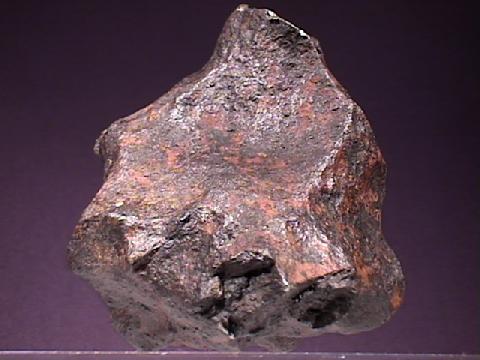

iro-15 ($350.00)
Gibbeon, Hoba, Namibia
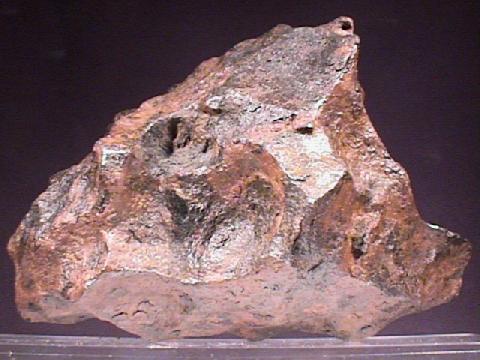
$1200.00
Dims: 6.5 x 4.3 x 4.2" (16.5 x 10.9 x 10.7 cm)
Wt: 11.2 lbs. (5.1 kg)
Gibbeon, Hoba, Namibia
This cabinet specimen represents the largest siderite (iron) Meteorite that we presently have in stock. Like most Iron meteorites, this specimen is coated with a moderately thick layer of oxidation, so that it generally has a rusty-brown coloration and a dull luster. However, several exposed points and edges have been abraded, so that the moderately pale silver-gray coloration and metallic luster of the Iron is visible. It has the standard amorphous shape of a meteorite, complete with generally concave faces and curved edges. It is slightly oily, as it has been coated with oil to stifle further oxidation. There is no host rock, of course.
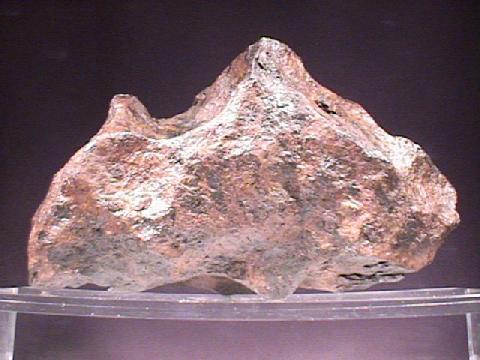

Gibbeon, Hoba, Namibia
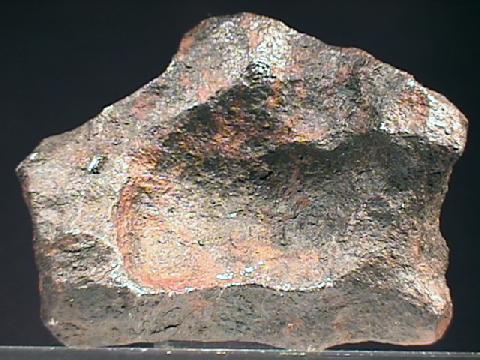
IRON specimen iro-17
$ 500.00
$ 500.00
Dims: 3.8 x 3.0 x 2.5" (9.7 x 7.6 x 6.4 cm)
Wt: 2 lbs., 12.3 oz. (1.255 kg)
Gibbeon, Hoba, Namibia
This hand specimen consists of a heavy, somewhat oxidized Iron meteorite. This meteorite shows no definite crystalline form and is only slightly damaged, in the form of small scuff marks and abrasions on exposed edges. All of its edges are curved and its faces are slightly concave. They are all covered with a thin layer of oxidized iron that has the classic rusty-brown color and dull luster. The abraded edges, however, show the white metal peeking through.
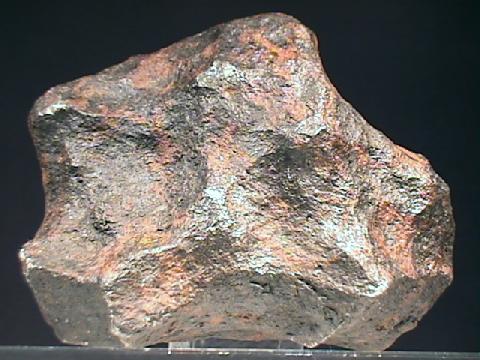

iro-17 ($500.00)
Gibbeon, Hoba, Namibia
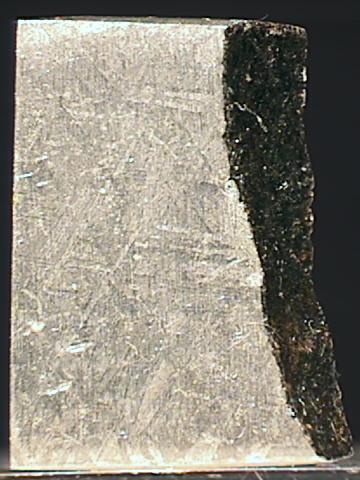
IRON specimen iro-18
$ 39.00
$ 39.00
Dims: 1.1 x 0.8 x 0.2" (2.8 x 2.0 x 0.5 cm)
Wt: 25.9 g
Gibbeon fall, near Hoba, Namibia
This thumbnail specimen consists of a small, cut piece of meteoric Iron/nickel. One surface is natural, and shows the uneven, dark brown coloration of its oxidized skin, though it appears to be lacquered. The other surfaces have been cut and sanded. They have also been etched in dilute nitric acid to reveal the Widmanstatten figures, caused by interaction of two slightly different Iron/nickel compounds.
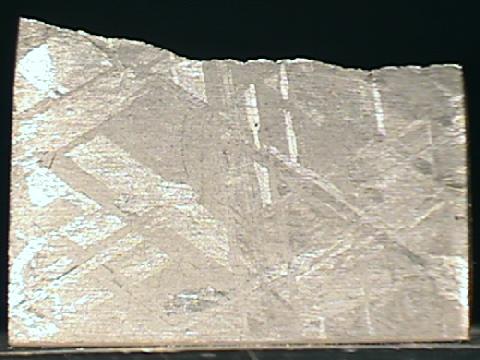

iro-18 ($ 39.00)
Gibbeon fall, near Hoba, Namibia

IRON specimen iro-19
$ 29.00
$ 29.00
Dims: 1.6 x 1,1 x 0.1" (4.1 x 2.8 x 0.3 cm)
Wt: 19.2 g
Gibbeon fall, near Hoba, Namibia
A small, thin slice of an Iron "siderite" meteorite makes up this specimen. The piece is cut, polished, and acid-etched on all surfaces but one. This other surface shows the rough, pitted and rust-stained natural surface of the meteorite. The other surfaces have the standard silvery-gray coloration and metallic luster of Iron and show the geometric patterns known as Widmanstatten figures that acid-etching exposes. A small, black carbonaceous nodule is embedded in the metal. The piece has been coated with a clear lacquer to prevent rust.

iro-19 ($ 29.00)
Gibbeon fall, near Hoba, Namibia
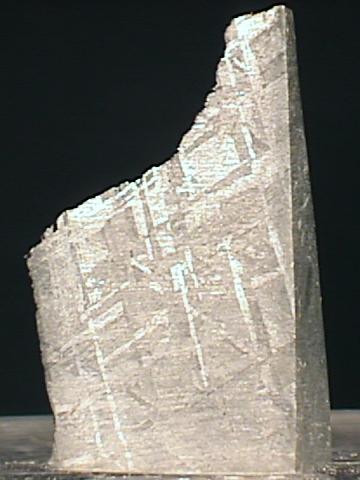
IRON specimen iro-20
$ 38.00
$ 38.00
Dims: 1.5 x 0.8 x 0.5" (3.8 x 2.0 x 1.3 cm)
Wt: 24.8 g
Gibbeon fall, near Hoba, Namibia
This large thumbnail piece consists of a partly-cut section of an Iron-nickel meteorite. All faces but one have been cut, polished, and then acid-etched. These faces show the silvery-gray color and dull metallic luster of the material and geometric patterns called Widmanstatten figures. The other face has a dark, rusty-brown coloration and a shiny luster caused by a lacquer coating.

iro-20 ($ 38.00)
Gibbeon fall, near Hoba, Namibia
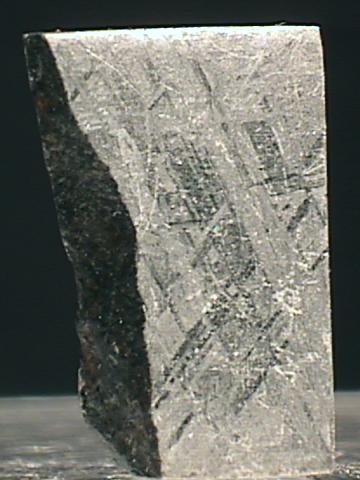
IRON specimen iro-21
$ 31.00
$ 31.00
Dims: 1.1 x 0.6 x 0.6" (2.8 x 1.5 x 1.5 cm)
Wt: 20.6 g
Gibbeon fall, near Hoba, Namibia
A partly-cut section of an Iron-nickel meteorite comprises this small specimen. Most of the surfaces have been cut and polished, revealing the silvery-gray color and metallic luster of the Iron, and then acid-etched to reveal the Widmanstatten figures that are present in such meteorites. The other surfaces, though somewhat worn, show the dark, rusty-brown color of the natural surface of the meteorite. The piece has been coated with a clear lacquer to prevent rusting.

iro-21 ($ 31.00)
Gibbeon fall, near Hoba, Namibia
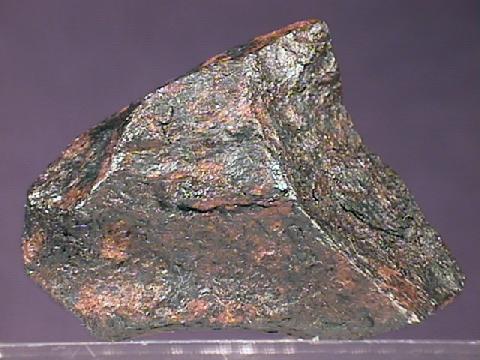
IRON specimen iro-22
$ 45.00
$ 45.00
Dims: 1.9 x 1.4 x 0.7" (4.8 x 3.4 x 1.8 cm)
Wt: 2.64 oz. (75.0 g)
Gibbeon fall, near Hoba, Namibia
This small meteorite has the standard rusty-brown outer surface and is in excellent condition, showing no fresh damage. Its surfaces are generally rough and slightly uneven, and most faces are concave.

iro-22 ($ 45.00)
Gibbeon fall, near Hoba, Namibia
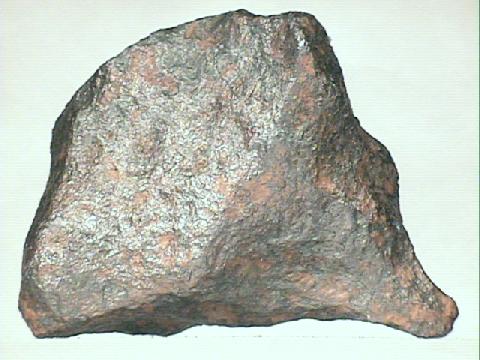
IRON specimen iro-23
$ 225.00
$ 225.00
Dims: 2.6 x 2.5 x 2.0" (6.6 x 6.3 x 5.2 cm)
Wt: 1 lb., 4.2 oz. (571 g)
Gibbeon fall, near Hoba, Namibia
This small cabinet specimen consists of a single chunk of an Iron-nickel meteorite. Its surfaces are coated with a dark, reddish-brown oxide, and most of its faces are concave. The Gibbeon fall is likely the most prolific producer of Iron-nickel meteorite specimens in the world.
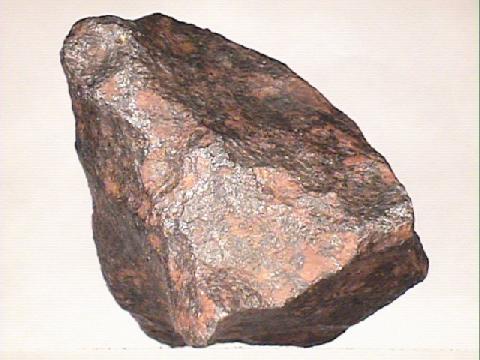

iro-23 ($225.00)
Gibbeon fall, near Hoba, Namibia
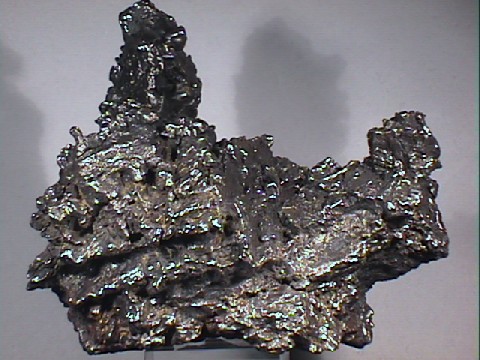
$2000.00
Dims: 6.5 x 5.0 x 4.5" (16.0 x 12.6 x 11.5 cm)
Wt: 7.5 lbs. (3.4 kg)
Nantan County, Guangxi, China
This is a wonderful specimen of the Nantan Meteorites, which fell to earth in May of 1516. These meteorites (first identified in 1958) were scattered over a 200 square kilometer area. Nantans fell in a humid region, and most specimens are heavily corroded. Once cleaned, however, specimens such as this one exhibit an octahedral crystal Widmanstatten pattern as surface features. This specimen is extremely impressive, as it shows an unusual "out of this world" and very aesthetic shape. Nantan meteorites are known to rust easily, and should be sprayed with a rust inhibitor (such as WD-40) every year or so.
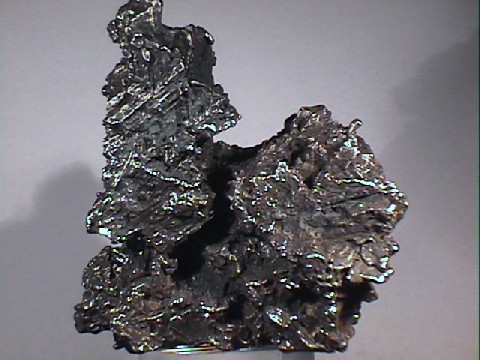

Nantan County, Guangxi, China
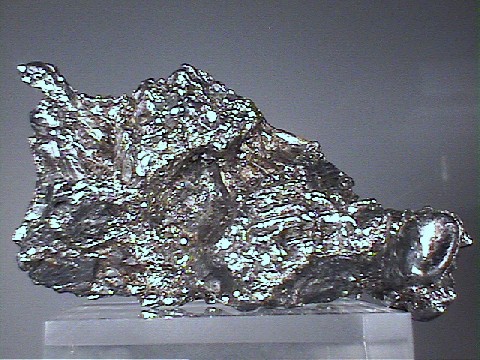
IRON specimen iro-25
$ 270.00
$ 270.00
Dims: 2.9x1.5x1.2" (7.3x3.9x3.0 cm)
Wt: 6.36 oz. (180.0 g)
Nantan County, Guangxi, China
This specimen of the Nantan Meteorites shows both burn pockets (surfaces exposed to the air during the meteorite's descent), and very clear octahedral crystal Widmanstatten patterns on two sides. The bulk of the specimen is a shiny metallic steel color, and the burnt areas are black and appear to have been oxidized to hematite. Like all iron/nickel meteorites, it should be sprayed with a rust inhibitor (such as WD-40) every year or so.
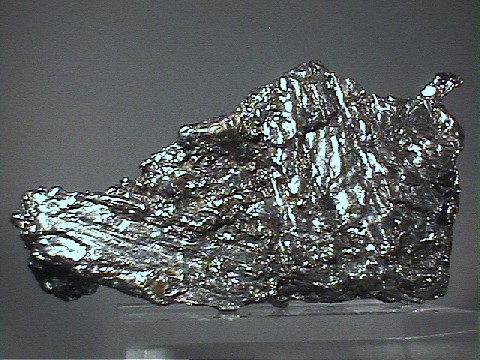

iro-25 ($270.00)
Nantan County, Guangxi, China
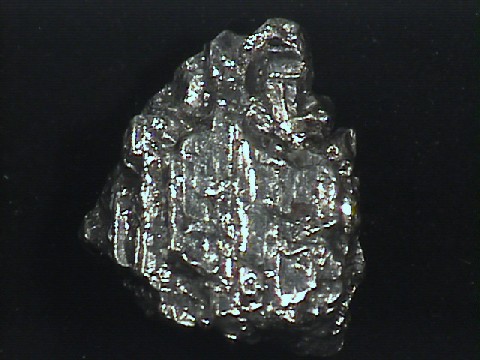
IRON specimen iro-27
$ 189.00
$ 189.00
Dims: 1.42x1.34x1.22" (3.6x3.4x3.1cm)
Wt: 4.35oz. (123.1g)
Nantan County, Guangxi, China
This is an excellent example of the Nantan meteorites. It has a complex shape including two rounded burn pockets (one with a small patch of oxide), and exposed crystal surfaces from the meteorite's octahedral Widmanstattan pattern. It is, of course, dense, and an excellent steel-gray metallic color, with darker areas in crevices providing good contrast and a pleasing visual texture.
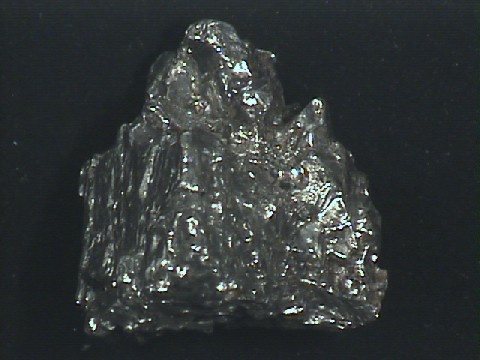

iro-27 ($189.00)
Nantan County, Guangxi, China
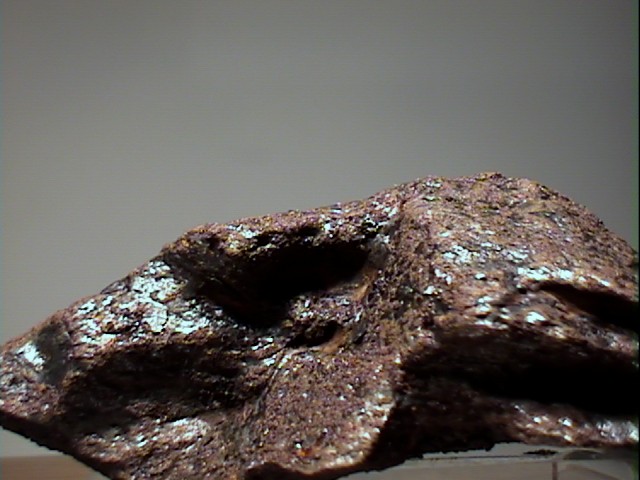
IRON specimen iro-30
$ 190.00
$ 190.00
Dims: 4.70x3.92x1.59" (11.94x9.96x4.03cm)
Wt: 38.9oz (1101g)
Gran Chaco Gualamba, Chaco, Argentina
This is a meteorite from the Campo del Cielo fall. It has not been polished, and is coated with a thin layer of rust in colors of rusty red and black. It's shape is relatively flat, so it is large for its weight. The edges tend to be sharp, and its cross section looks somewhat like the cross-section of an airplane wing - it is easy to imagine the direction of airflow that shaped this meteorite during its fiery descent through the atmosphere.
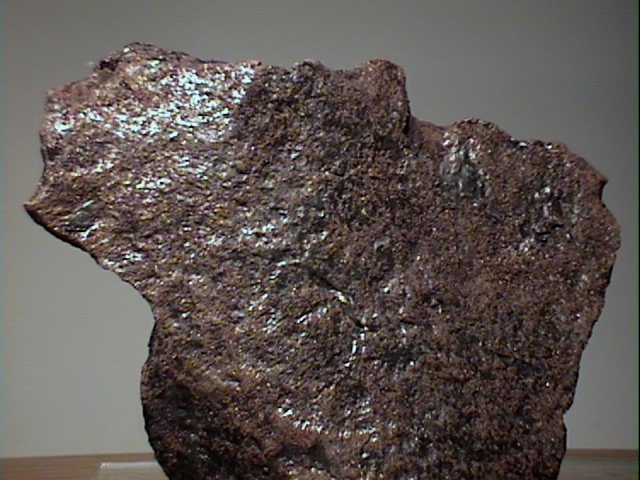

iro-30 ($190.00)
Gran Chaco Gualamba, Chaco, Argentina
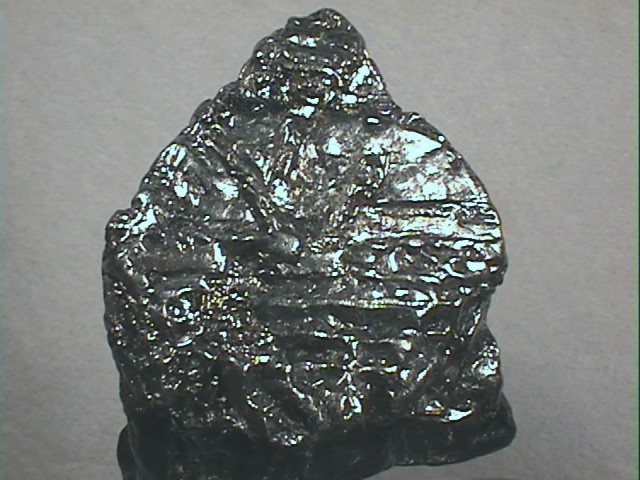
IRON specimen iro-31
$ 120.00
$ 120.00
Dims: 1.32x1.12x1.11" (3.36x2.84x2.83cm)
Wt: 2.56oz (72.5g)
Nantan County, Guangxi, China
This meteorite from the Nantan fall has approximately the shape of a 3 sided pyramid. The sides show a crystal pattern typical of Nantan meteorites (and caused by the breakup of the meteor in the lower atmosphere), while the base of the specimen is a thick layer of oxide (it appears to be hematite). The black base makes a nice contrast to the shiny silver metallic sides.
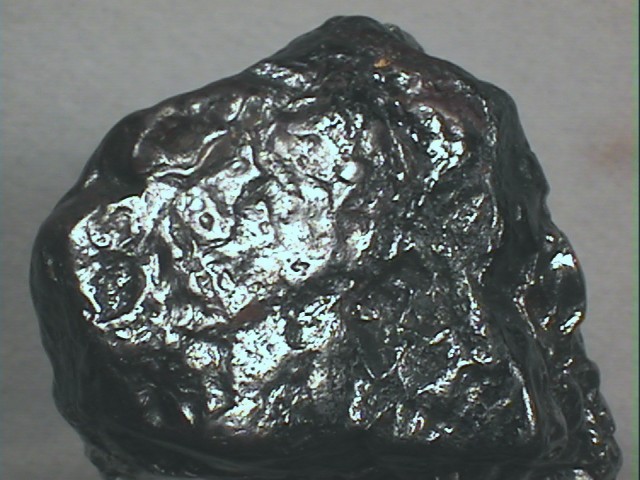

iro-31 ($120.00)
Nantan County, Guangxi, China

IRON specimen iro-33
$ 50.00
$ 50.00
Dims: 0.91x0.51x0.44" (2.32x1.29x1.13cm)
Wt: 0.20oz (5.7g)
Imilac, Chile
This is a meteorite from the strewn field near Imilac, Chile, the first of which was found in 1822. Some meteorites from this fall have large olivine crystals embedded in the nickel-iron matrix, making it a "Pallasite", but this specimen appears to be pure nickel-iron. It has a rough, complex shape that includes several blades extending beyond the buld of the specimen. The protected areas have a rusty coating, while the outer parts are a black iron color. Overall, this is a nice, distinctive Imilac meteorite.
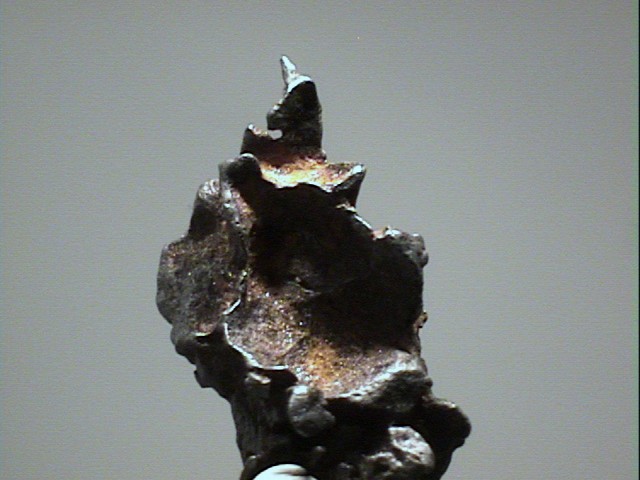

iro-33 ($ 50.00)
Imilac, Chile
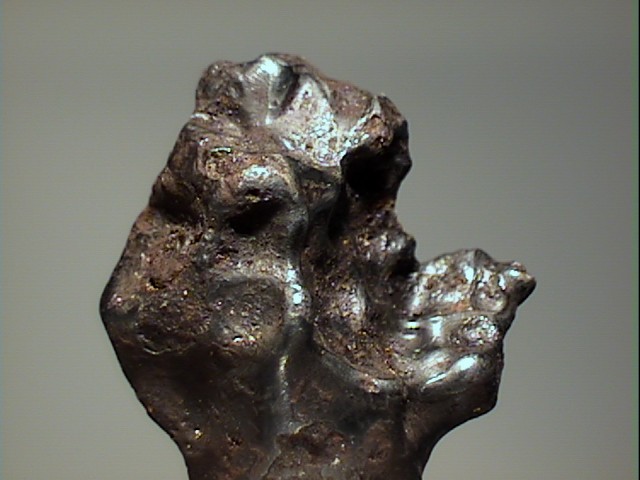
IRON specimen iro-32
$ 80.00
$ 80.00
Dims: 1.26x1.13x0.55" (3.21x2.86x1.39cm)
Wt: 0.92oz (26.1g)
Sikhote-Alin, Maritime Territory, Siberia
This meteorite is part of the largest witnessed meteor shower recorded, which occurred in Eastern Siberia on February 12, 1947. This specimen is black with small patches of rust in the pockets which are difficult to polish. The overall appearance is that of a typical meteorite fragment, with pits and burn pockets and some sharp edges and points.
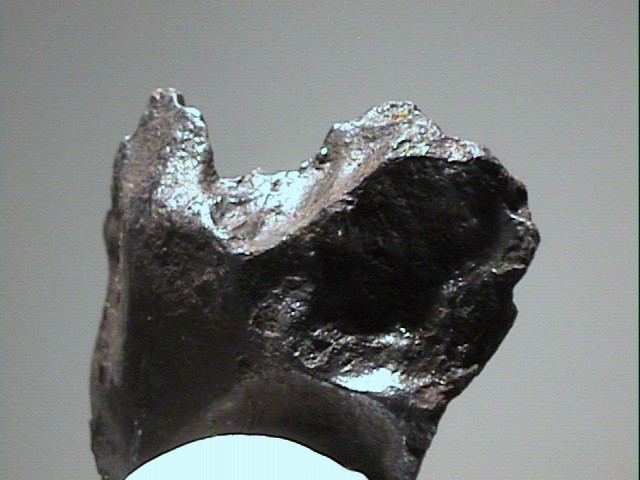

iro-32 ($ 80.00)
Sikhote-Alin, Maritime Territory, Siberia
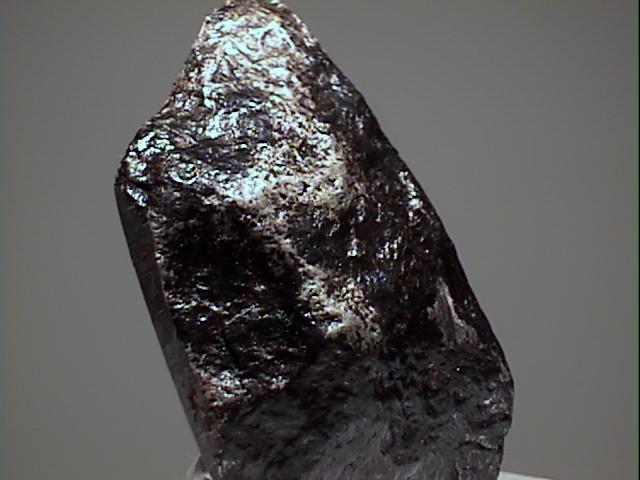
IRON specimen iro-34
$ 80.00
$ 80.00
Dims: 1.65x0.94x0.37" (4.18x2.39x0.95cm)
Wt: 1.22oz (34.6g)
Gibbeon fall, near Hoba, Namibia
This is an end-slice of a Gibeon meteorite. The base and face have been polished and etched to reveal the Widmanstatten pattern characteristic of the nickle-iron composition of this meteorite. The uncut side is partly iron-gray, and partly hematite black, with a rather rounded appearance (and a small saw mark). The cut side does exhibit two small cavities in the face which contain a small amount of rust.


iro-34 ($ 80.00)
Gibbeon fall, near Hoba, Namibia

IRON specimen iro-35
$ 120.00
$ 120.00
Dims: 1.49x1.37x0.88" (3.79x3.47x2.24cm)
Wt: 2.66oz (75.4g)
Nantan County, Guangxi, China
This meteorite from the Nantan fall in China just looks oriental to me. It reminds me of some Bonzai trees. The grooves on one side are generally aligned in a single direction, and on the flip side they are aligned in another direction. But on each side there is at least one groove or ridge which lines up with the other side. Most of the meteorite has the bright metallic silver color and luster of a well-prepared Nantan meteorite, plus there is a rounded patch of black, where the fiery descent through the atmosphere burned an area to hematite.
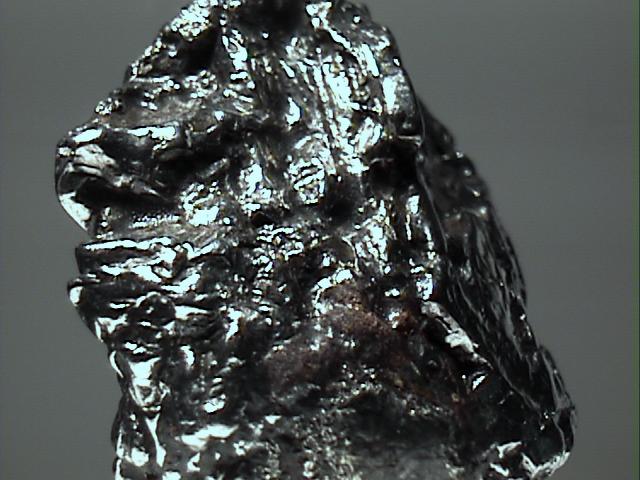

iro-35 ($120.00)
Nantan County, Guangxi, China
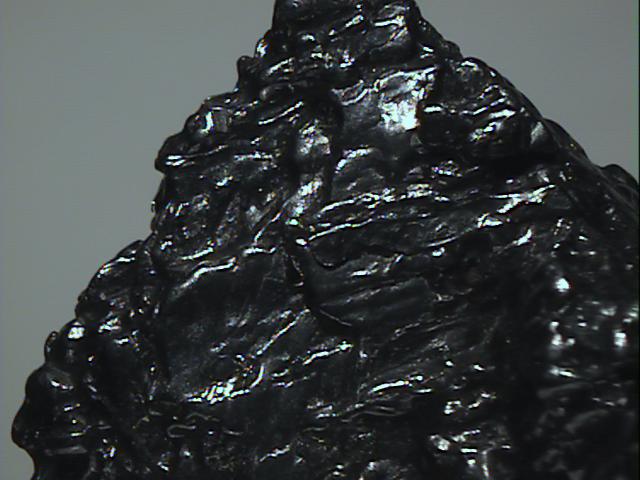
IRON specimen iro-36
$ 67.00
$ 67.00
Dims: 1.52x1.13x0.58" (3.85x2.88x1.47cm)
Wt: 1.45oz (40.9g)
Nantan County, Guangxi, China
This meteorite is part of the Nantan fall, and shows the characteristic angular form and strong crystal lines of such meteorites. Adding to its aesthetics is that the crevices have oxidized to black hematite, yielding a strong contrast to the bright metallic appearance of the polished Nantan meteorite. All of the crystal edges are at 120 degree angles, even the relatively flat bottom displays this angle against a small pyramid shaped section on the top.


iro-36 ($ 67.00)
Nantan County, Guangxi, China
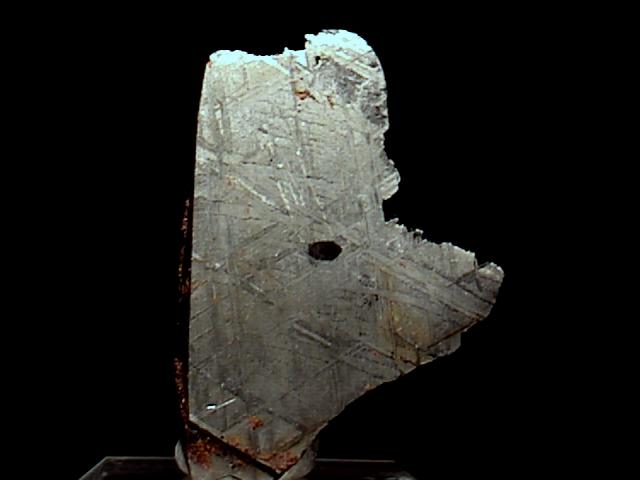
IRON specimen iro-29
$ 45.00
$ 45.00
Dims: 1.49x1.13x0.34" (3.77x2.87x0.86cm)
Wt: 0.71oz (20.2g)
Gibbeon strewn field, near Hoba, Namibia
This is an end slice of a Gibbeon meteorite. It also has a base cut so that it stands on its own. The cut faces are polished and etched to revel a strong Widmanstatten pattern. The back of this thin slice is the rough exterior to the meteorite. Of special note is that the polished face reveals a small dark inclusion, of unknown composition. A deep saw mark and a few pores and crevices on the specimen are rusting - a coat of oil should periodically be rubbed onto the meteorite to reduce further rusting. Note that Polishing the rust off will also remove the Widmanstatten pattern, and an acid bath would be needed to restore it.
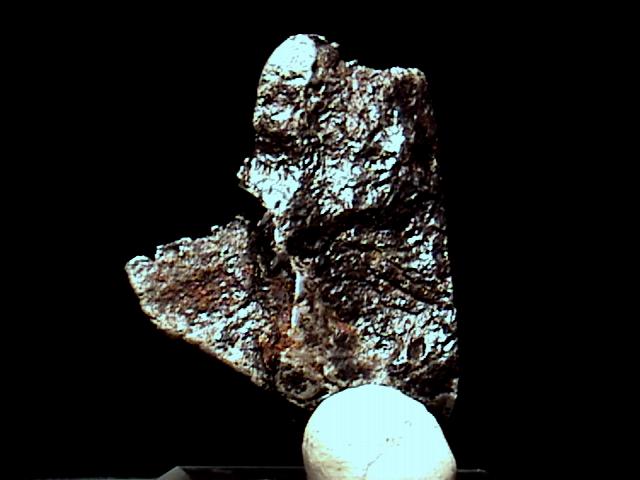

iro-29 ($ 45.00)
Gibbeon strewn field, near Hoba, Namibia
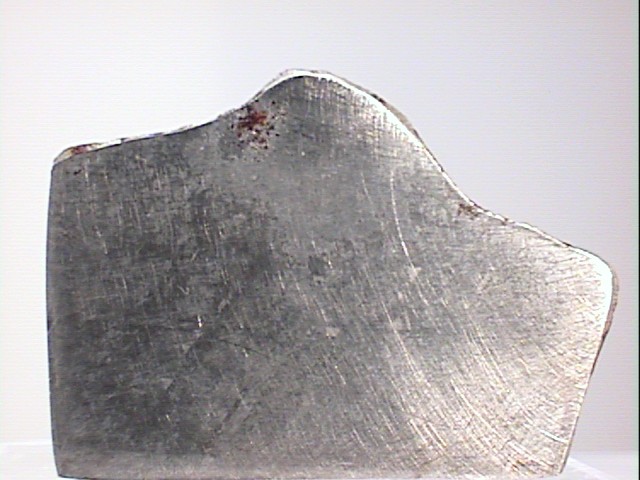
IRON specimen iro-37
$ 140.00
$ 140.00
Dims: 2.00x1.44x0.47" (5.09x3.67x1.21cm)
Wt: 2.30oz (65.2g)
Gibbeon desert, near Hoba, Namibia
This is an end slice of a Gibbeon meteorite, plus it has cuts on two more sides (the three cuts meet at right angles). At one time, all three cut faces had been polished and etched to show their Widmanstatten pattern, but the largest surface had been "cleaned" which removed the pattern.
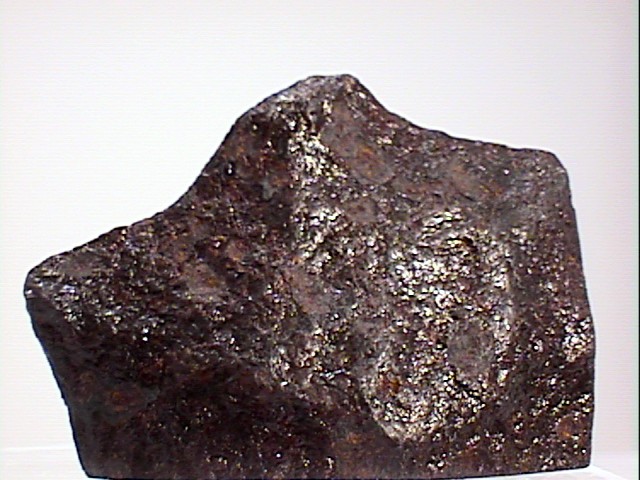

iro-37 ($140.00)
Gibbeon desert, near Hoba, Namibia
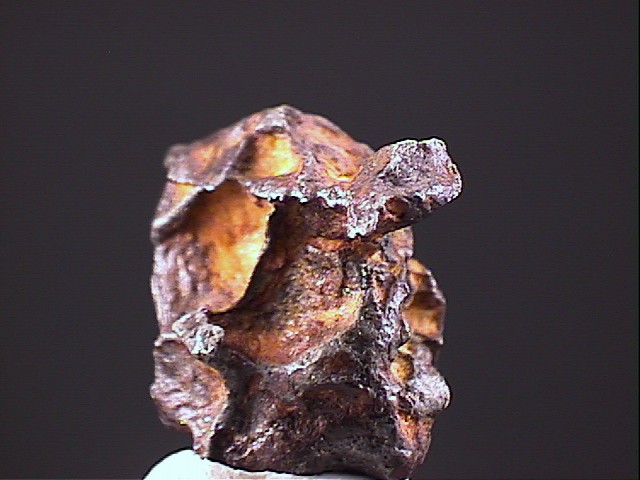
IRON specimen iro-38
$ 80.00
$ 80.00
Dims: 0.74x0.67x0.58" (1.87x1.71x1.48cm)
Wt: 0.31oz (8.7g)
Imilac, Chile
This is a good small meteorite from the Imilac strewn field. It has a highly irregular shape with nickel-iron ridges jutting between cavities containing a light colored rust. There is no sign of the olivine inclusions that make some Imilac meteorites "Pallasites".


iro-38 ($ 80.00)
Imilac, Chile

IRON specimen iro-50
$ 250.00
$ 250.00
Dims: 4.10x3.71x2.15" (10.40x9.42x5.47cm)
Wt: 46.07oz (1306g)
Gran Chaco Gualamba, Chaco, Argentina
This is a Campo del Cielo meteorite, named from the "field of heaven" in which they are found. It has an irregular shape, rather typical for iron meteorites, and having a good shape for an axe. The iron has the usual iron gray color, with numerous pits that have black interiors (probably hematite). Unfortunately, these Campo meteorites seem to rust very easily - I have cleaned and oiled this one several times, and yet it continues to rust. It may be a few grams lighter by the time you receive it, as I plan to clean it one last time before shipping!
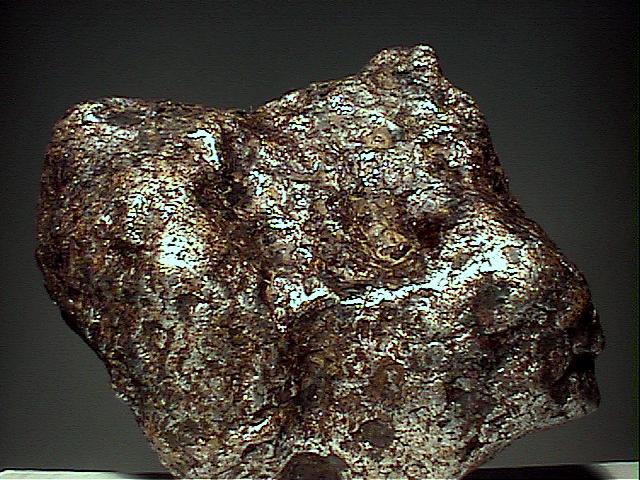

iro-50 ($250.00)
Gran Chaco Gualamba, Chaco, Argentina
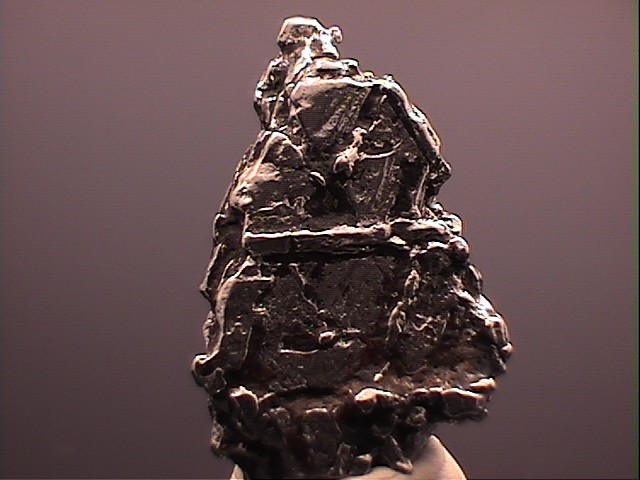
IRON specimen iro-39
$ 150.00
$ 150.00
Dims: 1.94x1.22x0.74" (4.93x3.10x1.87cm)
Wt: 1.87oz (52.9g)
Nantan County, Guangxi, China
This fine example of the Nantan meteorites displays excellent contrast as the pockets and grooves of the specimen contain a dark mineral (likely hematite) and the majority of the speicmen displays a bright silvery metallic finish. The 60 degree angles of the exposed widmanstatten pattern are obvious. This specimen has a roughly triangular shape and stands on 4 of its 5 faces, plus a corner.
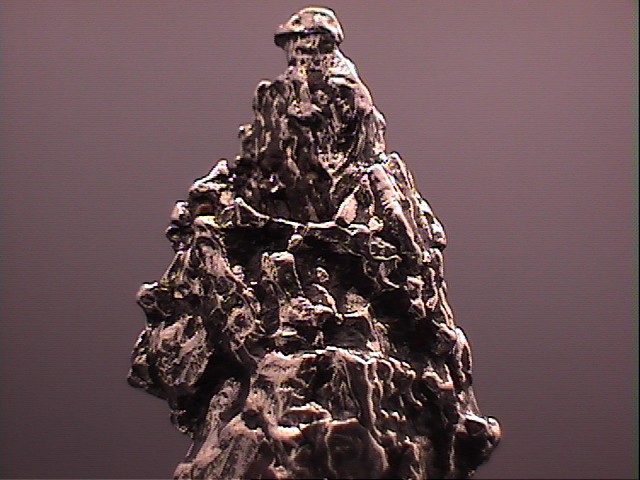

iro-39 ($150.00)
Nantan County, Guangxi, China

IRON specimen iro-40
$ 34.00
$ 34.00
Dims: 0.76x0.60x0.22" (1.93x1.51x0.55cm)
Wt: 0.13oz (3.7g)
Imilac, Chile
This is a typical small meteorite from the Imilac strewn field. It is highly irregular in shape, with several pits that appear caused by atmospheric ablation. The pits do contain an orange oxidation product; otherwise, the meteorite appears iron black.


iro-40 ($ 34.00)
Imilac, Chile

IRON specimen iro-41
$ 76.00
$ 76.00
Dims: 1.42x1.23x0.71in (3.61x3.13x1.82cm)
Wt: 1.67oz (47.3g)
Nantan County, Guangxi, China
This Nantan meteorite displays the excellent contrast of well-prepared meteorites from this fall. The grooves and pits are black (likely hematite), with the exterior surfaces are a shiny iron gray. Most of the surface displays a recognizable Widmanstatten pattern, although there is what appears to be a burn pocket of smooth hematite exposed.


iro-41 ($ 76.00)
Nantan County, Guangxi, China

IRON specimen iro-42
$ 46.00
$ 46.00
dims mm=27.15x20.38x5.50
wt g=5.1
Imilac, Chile
This trangular meteorite has the typical rough appearance and orange, rusty cavities of Imilac meteorites.


iro-42 ($ 46.00)
Imilac, Chile

IRON specimen iro-43
$ 165.00
$ 165.00
dims mm=55.09x32.01x29.65
wt g=102.3
Nantan County, Guangxi, China
Most of the surface of this meteor shows the obvious (although subtle) 120 degree crystal edges typical of Nantan meteorites. There is one intriguing surface that is smoothly rounded, almost like a bore hole, except that it displays a raised "X". I have no idea how this could have formed, yet I am certain that it is perfectly natural.


iro-43 ($165.00)
Nantan County, Guangxi, China